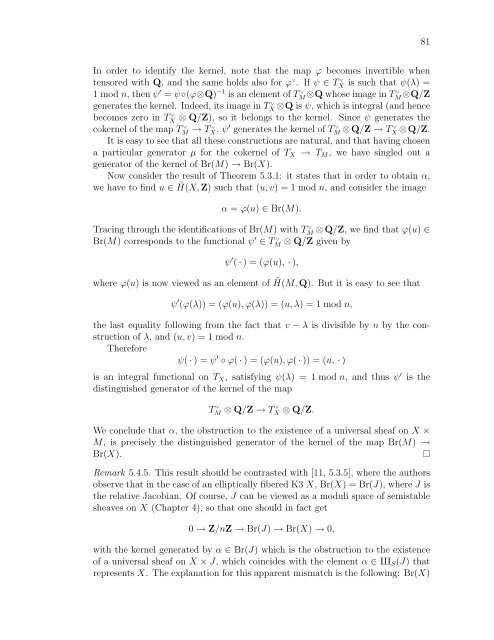derived categories of twisted sheaves on calabi-yau manifolds
derived categories of twisted sheaves on calabi-yau manifolds
derived categories of twisted sheaves on calabi-yau manifolds
Create successful ePaper yourself
Turn your PDF publications into a flip-book with our unique Google optimized e-Paper software.
In order to identify the kernel, note that the map ϕ becomes invertible when<br />
tensored with Q, and the same holds also for ϕ∨ . If ψ ∈ T ∨<br />
X is such that ψ(λ) =<br />
1 mod n, then ψ ′ = ψ◦(ϕ⊗Q) −1 is an element <str<strong>on</strong>g>of</str<strong>on</strong>g> T ∨<br />
∨<br />
M ⊗Q whose image in TM ⊗Q/Z<br />
generates the kernel. Indeed, its image in T ∨<br />
X ⊗Q is ψ, which is integral (and hence<br />
becomes zero in T ∨<br />
X ⊗ Q/Z), so it bel<strong>on</strong>gs to the kernel. Since ψ generates the<br />
cokernel <str<strong>on</strong>g>of</str<strong>on</strong>g> the map T ∨<br />
∨<br />
M → TX , ψ′ generates the kernel <str<strong>on</strong>g>of</str<strong>on</strong>g> T ∨<br />
∨<br />
M ⊗ Q/Z → TX ⊗ Q/Z.<br />
It is easy to see that all these c<strong>on</strong>structi<strong>on</strong>s are natural, and that having chosen<br />
a particular generator µ for the cokernel <str<strong>on</strong>g>of</str<strong>on</strong>g> TX → TM, we have singled out a<br />
generator <str<strong>on</strong>g>of</str<strong>on</strong>g> the kernel <str<strong>on</strong>g>of</str<strong>on</strong>g> Br(M) → Br(X).<br />
Now c<strong>on</strong>sider the result <str<strong>on</strong>g>of</str<strong>on</strong>g> Theorem 5.3.1: it states that in order to obtain α,<br />
we have to find u ∈ ˜ H(X, Z) such that (u, v) = 1 mod n, and c<strong>on</strong>sider the image<br />
α = ϕ(u) ∈ Br(M).<br />
Tracing through the identificati<strong>on</strong>s <str<strong>on</strong>g>of</str<strong>on</strong>g> Br(M) with T ∨<br />
M ⊗ Q/Z, we find that ϕ(u) ∈<br />
Br(M) corresp<strong>on</strong>ds to the functi<strong>on</strong>al ψ ′ ∈ T ∨<br />
M ⊗ Q/Z given by<br />
ψ ′ ( · ) = (ϕ(u), · ),<br />
where ϕ(u) is now viewed as an element <str<strong>on</strong>g>of</str<strong>on</strong>g> ˜ H(M, Q). But it is easy to see that<br />
ψ ′ (ϕ(λ)) = (ϕ(u), ϕ(λ)) = (u, λ) = 1 mod n,<br />
the last equality following from the fact that v − λ is divisible by n by the c<strong>on</strong>structi<strong>on</strong><br />
<str<strong>on</strong>g>of</str<strong>on</strong>g> λ, and (u, v) = 1 mod n.<br />
Therefore<br />
ψ( · ) = ψ ′ ◦ ϕ( · ) = (ϕ(u), ϕ( · )) = (u, · )<br />
is an integral functi<strong>on</strong>al <strong>on</strong> TX, satisfying ψ(λ) = 1 mod n, and thus ψ ′ is the<br />
distinguished generator <str<strong>on</strong>g>of</str<strong>on</strong>g> the kernel <str<strong>on</strong>g>of</str<strong>on</strong>g> the map<br />
T ∨<br />
M ⊗ Q/Z → T ∨<br />
X ⊗ Q/Z.<br />
We c<strong>on</strong>clude that α, the obstructi<strong>on</strong> to the existence <str<strong>on</strong>g>of</str<strong>on</strong>g> a universal sheaf <strong>on</strong> X ×<br />
M, is precisely the distinguished generator <str<strong>on</strong>g>of</str<strong>on</strong>g> the kernel <str<strong>on</strong>g>of</str<strong>on</strong>g> the map Br(M) →<br />
Br(X).<br />
Remark 5.4.5. This result should be c<strong>on</strong>trasted with [11, 5.3.5], where the authors<br />
observe that in the case <str<strong>on</strong>g>of</str<strong>on</strong>g> an elliptically fibered K3 X, Br(X) = Br(J), where J is<br />
the relative Jacobian. Of course, J can be viewed as a moduli space <str<strong>on</strong>g>of</str<strong>on</strong>g> semistable<br />
<str<strong>on</strong>g>sheaves</str<strong>on</strong>g> <strong>on</strong> X (Chapter 4), so that <strong>on</strong>e should in fact get<br />
0 → Z/nZ → Br(J) → Br(X) → 0,<br />
with the kernel generated by α ∈ Br(J) which is the obstructi<strong>on</strong> to the existence<br />
<str<strong>on</strong>g>of</str<strong>on</strong>g> a universal sheaf <strong>on</strong> X × J, which coincides with the element α ∈ XS(J) that<br />
represents X. The explanati<strong>on</strong> for this apparent mismatch is the following: Br(X)<br />
81
















